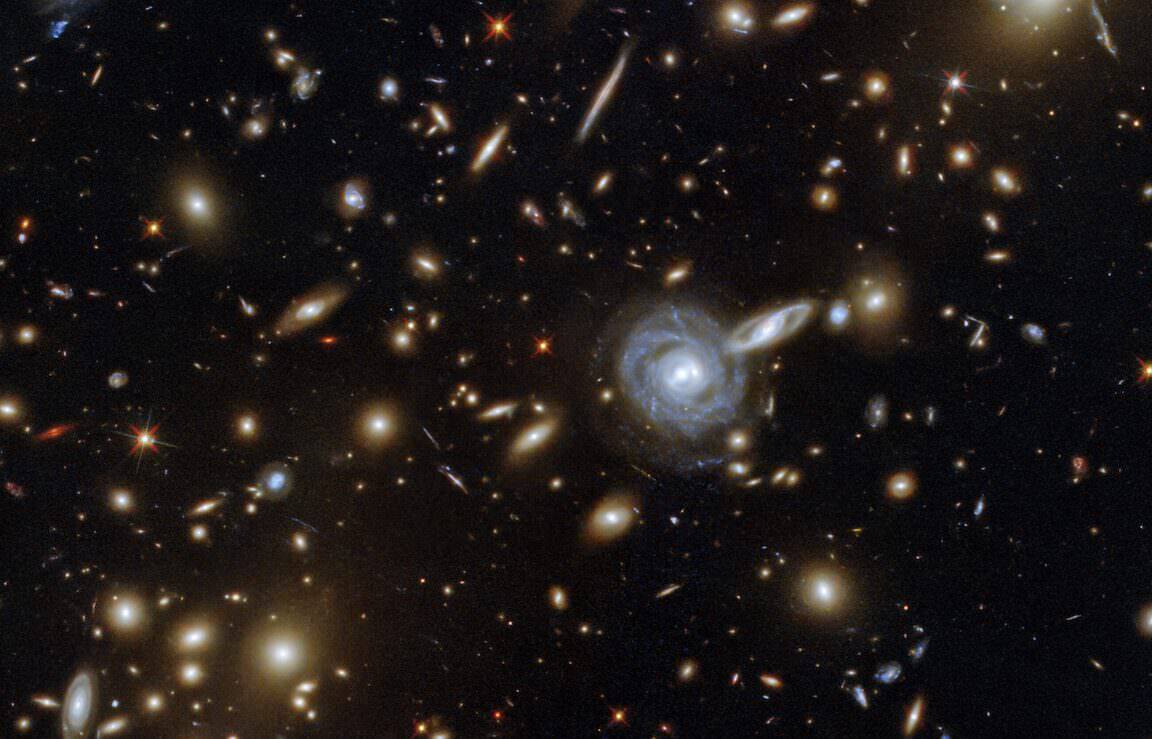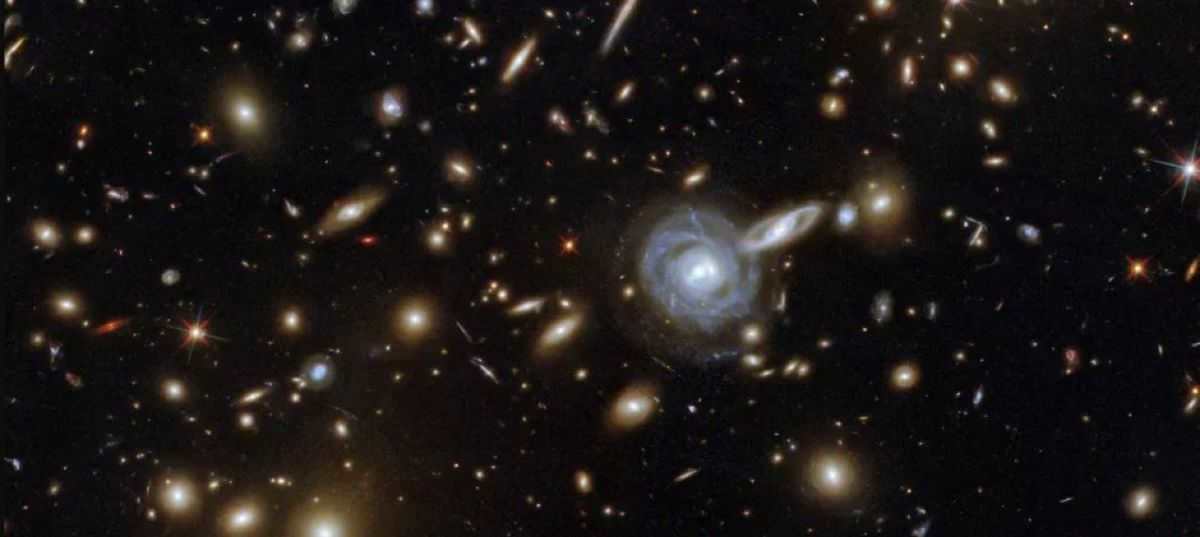
Galaxies are vast collections of star systems. However, determining the exact number of galaxies in the universe is an immensely challenging task. The sheer magnitude of galaxies makes counting them a daunting undertaking. Currently, the count is beyond comprehension. The sheer quantity poses a major obstacle, even simple addition becomes time-consuming when dealing with billions. Additionally, our equipment’s limitations hinder our ability to accurately determine the total number. Presently, we can only detect a few tens of billions of galaxies in the vast expanse of the sky. To expand our view, we require more advanced equipment with larger apertures. Furthermore, positioning the telescope in the Earth’s orbit is crucial to avoid atmospheric interference during observations.
Arguably the most extensive collection of galaxies ever captured comes in the form of the Hubble eXtreme Deep Field (XDF) image, which was created by merging various photographs taken by the Hubble Space Telescope during its 10 years of operation. The telescope focused on different sections of the celestial sky for 50-day periods, meticulously gathering faint light emitted by distant stars. Consequently, the Hubble managed to detect thousands of galaxies, ultimately producing the XDF, which stood as the largest cosmic image of its time. This monumental discovery allowed scientists to estimate that there are between 100 and 200 billion galaxies that can be observed from Earth using a similar approach. Nevertheless, the recent launch of the James Webb Space Telescope holds the promise of unveiling even more comprehensive insights into the vastness of the universe.
Exploring the mysteries of galaxies
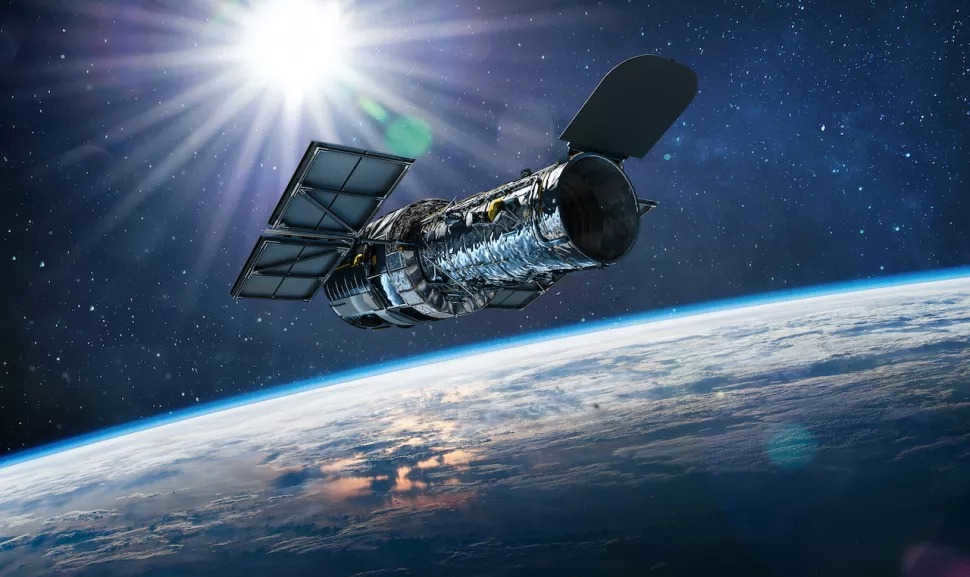
According to astrophysicist Mario Livio from the Space Telescope Science Institute in Baltimore, USA, Hubble has successfully tallied the number of visible galaxies. When it was launched in 1990, the telescope’s primary mirror had a distortion that was not rectified until 1993. From then until 2009, the telescope underwent direct in-orbit corrections and modernizations with the assistance of the shuttle.
In 1995, the telescope’s lens was directed towards an apparently empty region near the Big Dipper and observed for 10 days. The outcome of this observation was the discovery of approximately three thousand faint galaxies with a stellar magnitude of 30. (To put it into perspective, Polaris has a stellar magnitude of around 2.)
“In total, Hubble has discovered approximately one hundred billion galaxies in the observable universe. This figure could potentially double with the advancement of space observation technologies like the James Webb’s,” Livio states.
Quantifying celestial bodies
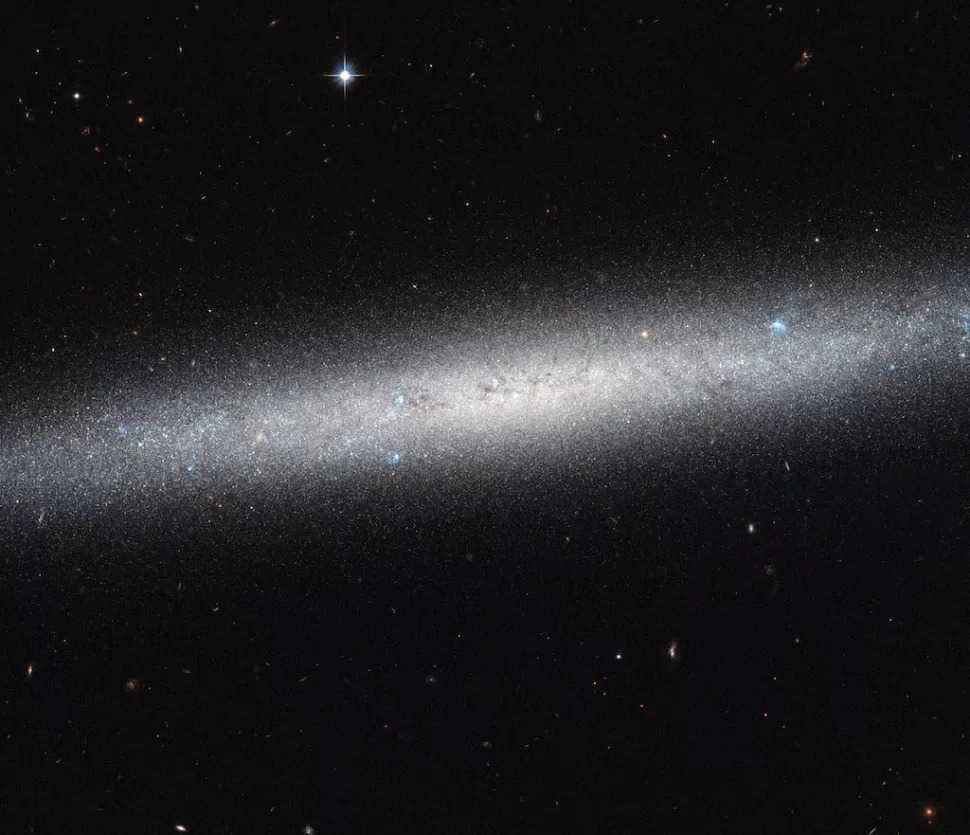
The process of estimating the number of galaxies in the universe remains the same regardless of the telescope used. The astronomers simply capture a portion of the night sky through the telescope and then calculate the number of galaxies based on the proportion of that portion to the entire observable universe.
“This method assumes the absence of significant cosmic variations and the homogeneity of the universe,” explains Livio. “And there are compelling reasons to believe in this assumption. In fact, it is known as the cosmological principle.”
The concept of the cosmological principle originated with Einstein’s OTO theory, which posited that gravity is a distortion of space and time. Building upon this idea, researchers, including Einstein himself, have endeavored to understand the precise impact of gravity on the entire cosmos.
“A straightforward assumption is that if one were to observe the universe with limited visual acuity, it would appear fairly uniform in all directions,” NASA explained.
An excellent illustration of the cosmological principle can be seen in the cosmic microwave background. This radiation is a remnant from the early stages of the Universe following the occurrence of the Big Bang. By employing instruments like the Wilkinson Probe to measure variations in the radiation, scientists have discovered that this ancient energy is uniformly distributed throughout the Universe.
Is the number of galaxies subject to change over time?
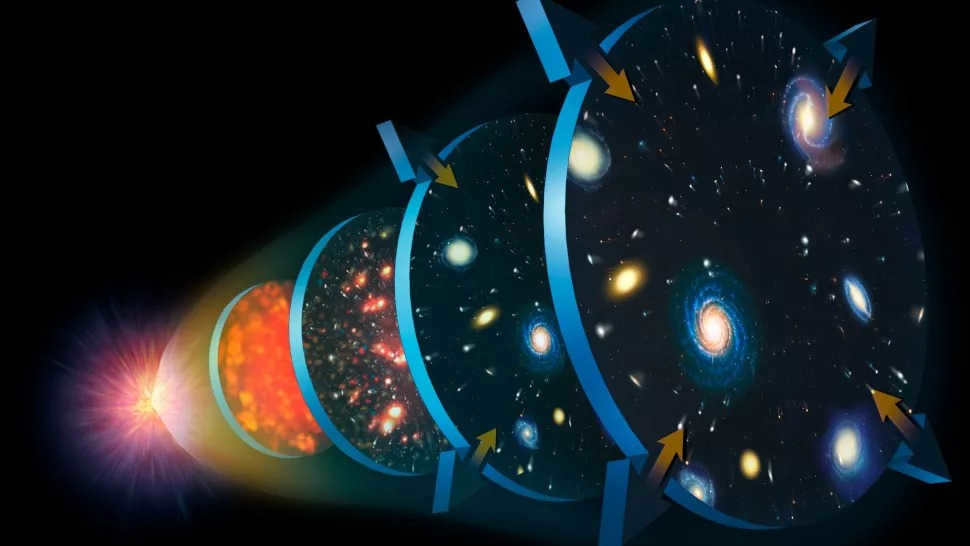
The study of the expansion of the Universe has been conducted by observing the movement of galaxies as they drift away from us. This exploration has allowed us to determine its precise age – 13.82 billion years. However, as this expansion persists, galaxies are moving further away from our planet, making it increasingly challenging to observe them.
The expansion is occurring at a rate faster than the speed of light (which is not in contradiction with the principles of GR, as it stems from the Universe itself rather than objects within it) and is even accelerating over time. This is where the concept of the “observable universe” – the portion of the cosmos that we are capable of observing – becomes relevant. Livio suggests that in approximately one trillion years, new galaxies will emerge that are beyond our sight from Earth.
“According to Livio, our ability to observe galaxies is limited to those whose light has had enough time to reach us. However, this does not imply that there is nothing else in the universe, which is why we use the concept of the observable universe,” Livio explained.
Furthermore, galaxies undergo changes over time. For instance, our Milky Way and the neighboring Andromeda galaxy are gradually moving towards each other and are expected to merge in approximately 4 billion years. The same process will occur with the other galaxies in our Local Group, eventually leading to their fusion into one. Livio suggests that the future inhabitants of this colossal galaxy will perceive a significantly darker version of the universe compared to our current perspective.
“In the past, civilizations may not have had any evidence of the existence of a universe with 100 billion galaxies,” he explained. – “However, future civilizations may not witness any expansion and might even lack the ability to confirm the actual occurrence of the Big Bang.”
How about exploring alternate universes?
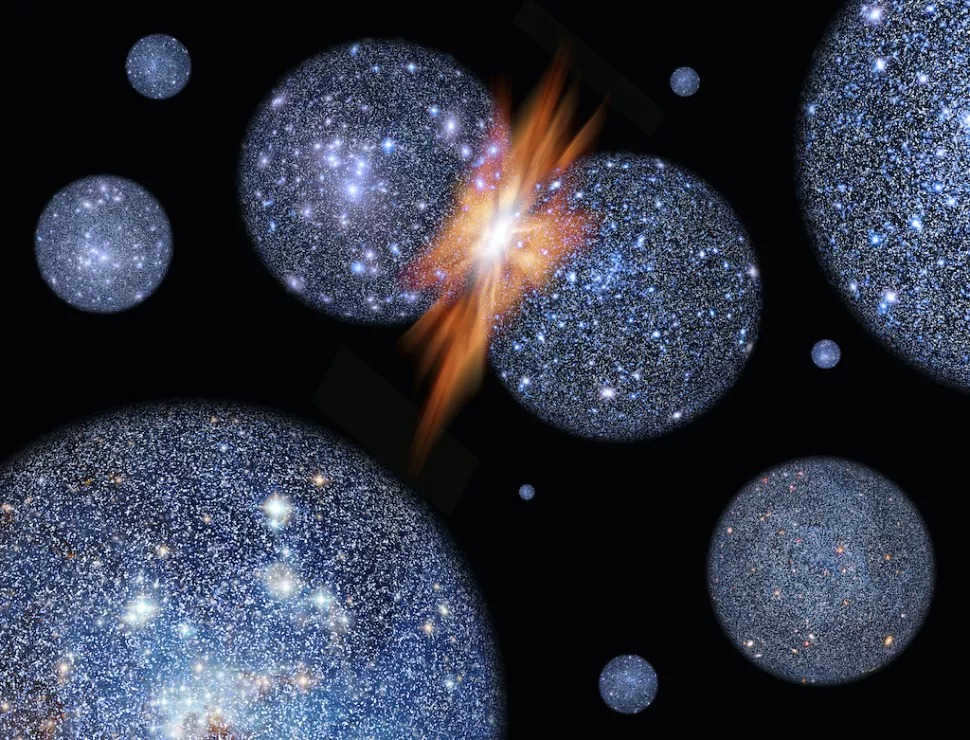
There exist theories in the field of physics that posit that during the expansion of the universe, certain regions became detached from it and gave rise to other separate universes. These alternate universes may possess distinct rates of expansion, particles, matter, and even physical laws that differ from our own.
Livio suggests that these universes likely contain their own galaxies as well (if they indeed exist), although this cannot be confirmed. Consequently, if we take into account the possibility of other worlds, the number of existing galaxies could be even more expansive.
Livio expresses the hope that the equipment of James Webb will provide a more precise estimation of the quantity of galaxies present in our universe. While the Hubble telescope was able to observe galaxies that formed approximately 450 million years after the inception of time, astronomers believe that the James Webb telescope will have the capability to peer even further into the future and observe galaxies that emerged around 200 million years after the occurrence of the Big Bang.
Livio suggests that the numbers are unlikely to undergo significant changes, considering that the formation of the first galaxies took place around the same time period that we are able to observe. Therefore, it is reasonable to estimate that there are approximately 200 billion galaxies in the observable universe.
What capabilities does James Webb possess?
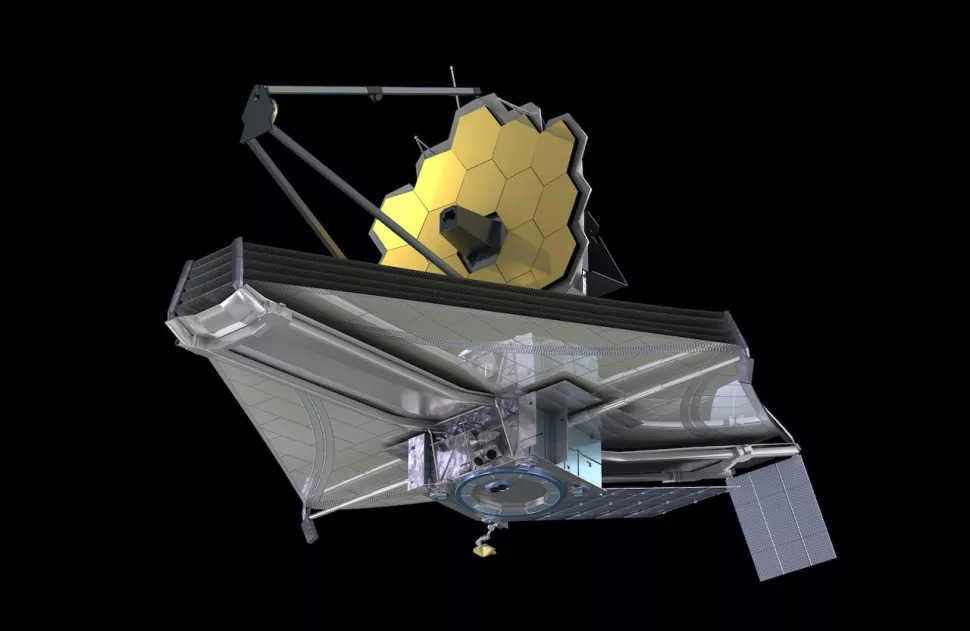
Although it is fascinating to count the number of galaxies in the Universe, astronomers have other priorities. Their focus lies in the ability of galaxies to provide insights into the formation of the universe. By observing them, scientists can gain a better understanding of how matter dispersed throughout the universe following the Big Bang. With its ability to peer beyond Hubble, the Webb telescope holds the potential to enhance our knowledge of galaxy structure.
“Studying older galaxies and comparing them to previous observations can enhance our understanding of their formation and evolution. The Webb mission by NASA aims to assist scientists in gathering valuable information about the types of stars that originated in these ancient galaxies,” stated NASA. “Conducting follow-up observations using spectroscopy on hundreds or even thousands of galaxies will aid researchers in comprehending the process of how elements heavier than hydrogen were formed and accumulated as galaxies developed throughout time. These studies will also uncover intricate details about galaxy mergers and shed light on the overall process of galaxy formation.”
NASA believes that James Webb will be able to address the following important questions:
- What are the mechanisms behind galaxy formation?
- What factors contribute to their distinctive shapes?
- How are chemical elements distributed across galaxies?
- What are the consequences of the collision or merger of small and large galaxies?
In addition, scientists are attempting to ascertain the significance of dark matter in these phenomena. Despite the fact that galaxies and stars dominate our observations of space, dark matter accounts for approximately 80% of the universe. It cannot be detected through any form of radiation or wavelengths, but researchers demonstrated in the 1950s that galaxies are actually more massive than they appear. Consequently, there is a significant amount of unobservable mass in the cosmos.
The capabilities of the James Webb Telescope’s instrumentation will provide astronomers with enhanced opportunities to investigate the phenomenon of galaxy formation and gain insights into the role of dark matter in this process. While it may not directly facilitate a more precise determination of the number of galaxies in our Universe, it will undoubtedly contribute to a deeper comprehension of the mechanisms underlying their creation.
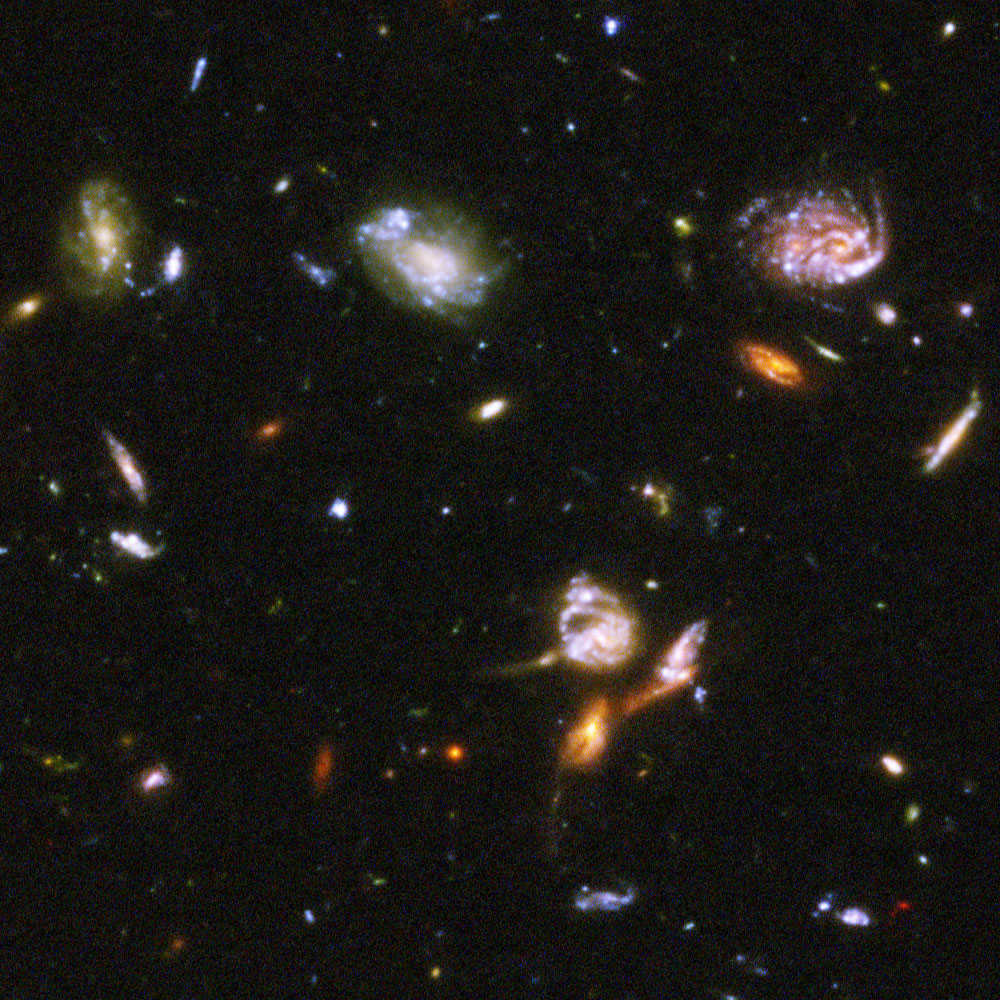

The Hubble Ultra Deep Field captures a glimpse of the vastness of the cosmos, revealing countless galaxies scattered across the expanse. It was Edwin Hubble, a renowned astronomer, who revolutionized our understanding of the Universe in 1920. His groundbreaking work proved that our Milky Way is just one of many galaxies that exist. Today, we have grown accustomed to the idea that the Universe is teeming with thousands, even millions, of galaxies, making our own appear minuscule in comparison. But how many galaxies reside in close proximity to us? Let’s discover the answer to that intriguing question.
From unity to eternity
It may seem unbelievable, but even our ancestors, including the most scientifically inclined, regarded our Milky Way as a metagalaxy – a celestial entity that spans the entire observable Universe. Their misconception was reasonably explained by the limitations of telescopes during that era – even the most advanced telescopes of the time only revealed galaxies as indistinct smudges, hence they were universally referred to as nebulae. The prevailing belief was that stars and planets would eventually emerge from these nebulae, just as our own solar system had formed in the past. This hypothesis gained support with the discovery of the first planetary nebula in 1796, which contained a central star. As a result, scientists concluded that all other nebulous objects in the sky represented similar clusters of dust and gas, where stars had not yet had sufficient time to coalesce.
Getting Started
Of course, advancements were constantly being made. As early as 1845, William Parsons constructed a massive telescope called the “Leviathan,” which was nearly two meters in size. His intention was to demonstrate that the “nebulae” were actually made up of stars, thereby bringing astronomy closer to the contemporary understanding of galaxies. Parsons was the first to observe the spiral form of individual galaxies and also identified variations in luminosity within them, which corresponded to exceptionally large and brilliant star clusters.
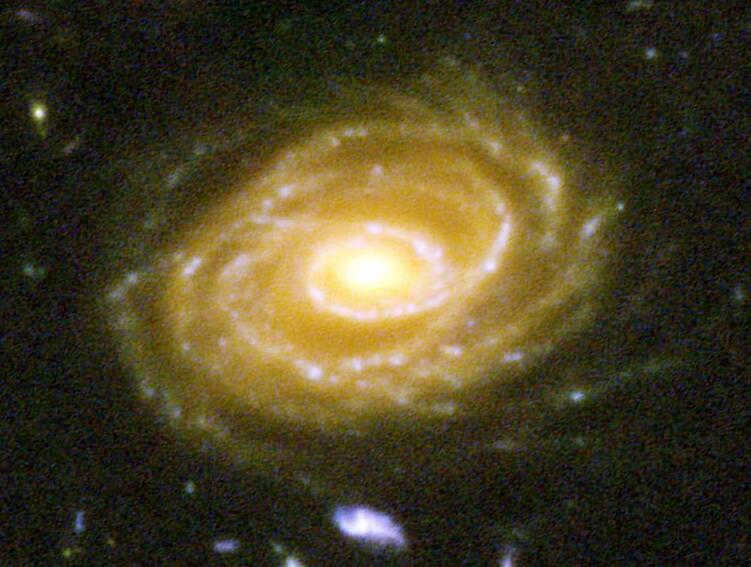
Despite the advancements in space telescopes, galaxies in images still frequently appear blurred.
Nevertheless, the discussion continued until the 1900s. While the progressive scientific community had already acknowledged the existence of numerous galaxies apart from the Milky Way, official academic astronomy required indisputable proof. Consequently, telescopes worldwide focused their lenses on the nearest expansive galaxy to us, which had previously been incorrectly identified as a nebula – the Andromeda Galaxy.
In 1888, Isaac Roberts captured the inaugural image of Andromeda, and additional photographs were taken during the period of 1900-1910. These images depicted the luminous galactic core as well as distinct star clusters. However, due to the limited resolution of the photographs, inaccuracies were introduced. What appeared to be star clusters might have actually been nebulae or a grouping of multiple stars that appeared as one during the exposure. Nonetheless, the definitive answer to this query was just around the corner.

The inaugural image of the Andromeda galaxy was captured in 1888.
A contemporary depiction
In 1924, utilizing the groundbreaking telescope of the early 1900s, Edwin Hubble successfully approximated the distance to the Andromeda galaxy. The measurement revealed a magnitude so vast that it completely ruled out the possibility of the object being part of the Milky Way (though Hubble’s estimation was three times smaller than the current one). Additionally, the astronomer discovered an abundance of stars within the “nebula,” providing definitive evidence of Andromeda’s galactic nature. In 1925, despite facing criticism from his peers, Hubble presented his findings at a conference hosted by the American Astronomical Community.
This presentation sparked a new era in the field of astronomy as scientists “reclaimed” nebulae and reclassified them as galaxies, while also uncovering new ones. Hubble’s own groundbreaking findings, like the identification of redshift, greatly contributed to their efforts. The development and deployment of advanced telescopes, including the widespread adoption of radio telescopes following World War II, further expanded our knowledge of galaxies.
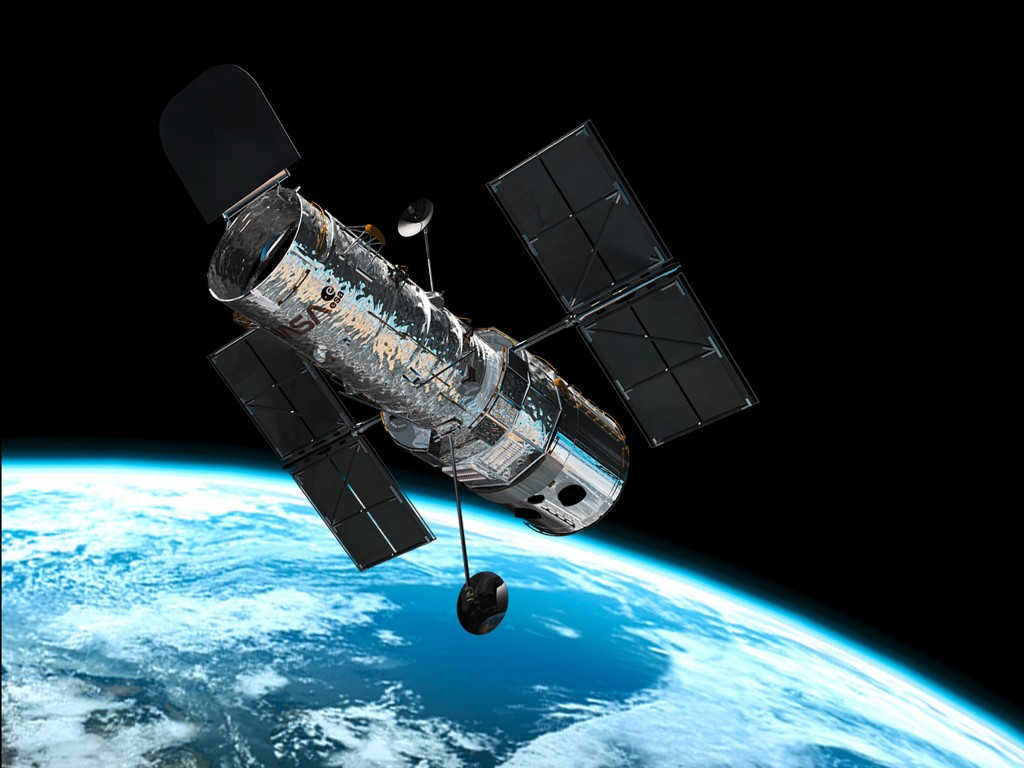
The Hubble telescope, which is located in Earth’s orbit, has provided a unique opportunity for people to observe the bright disks of galaxies that were once thought to be small nebulae. Additionally, this groundbreaking telescope has revealed a previously unknown abundance of galaxies, disproving the notion that the sky is empty. In fact, the number of stars visible to the Hubble telescope is only a fraction of their true quantity.
Nevertheless, the question remains: just how many galaxies are there in the vast expanse of the Universe? It is important to note that astronomers do not typically concern themselves with such inquiries, as they hold little scientific significance. Their focus lies more on cataloging and studying galaxies for broader purposes, such as unraveling the intricacies of the Universe’s grand structure.
However, it is a task that no one dares to undertake. Firstly, our Universe is boundless, rendering the compilation of a comprehensive galaxy registry an arduous and unfeasible endeavor. Secondly, even if we were to confine ourselves to counting the galaxies within the visible boundaries of the Universe, it would require an astronomer’s entire lifespan. Even if an astronomer were to dedicate 80 years to counting galaxies from birth and allocate no more than a second to detect and document each one, they would only manage to identify a mere 2 billion entities – a paltry fraction of the actual number of galaxies.
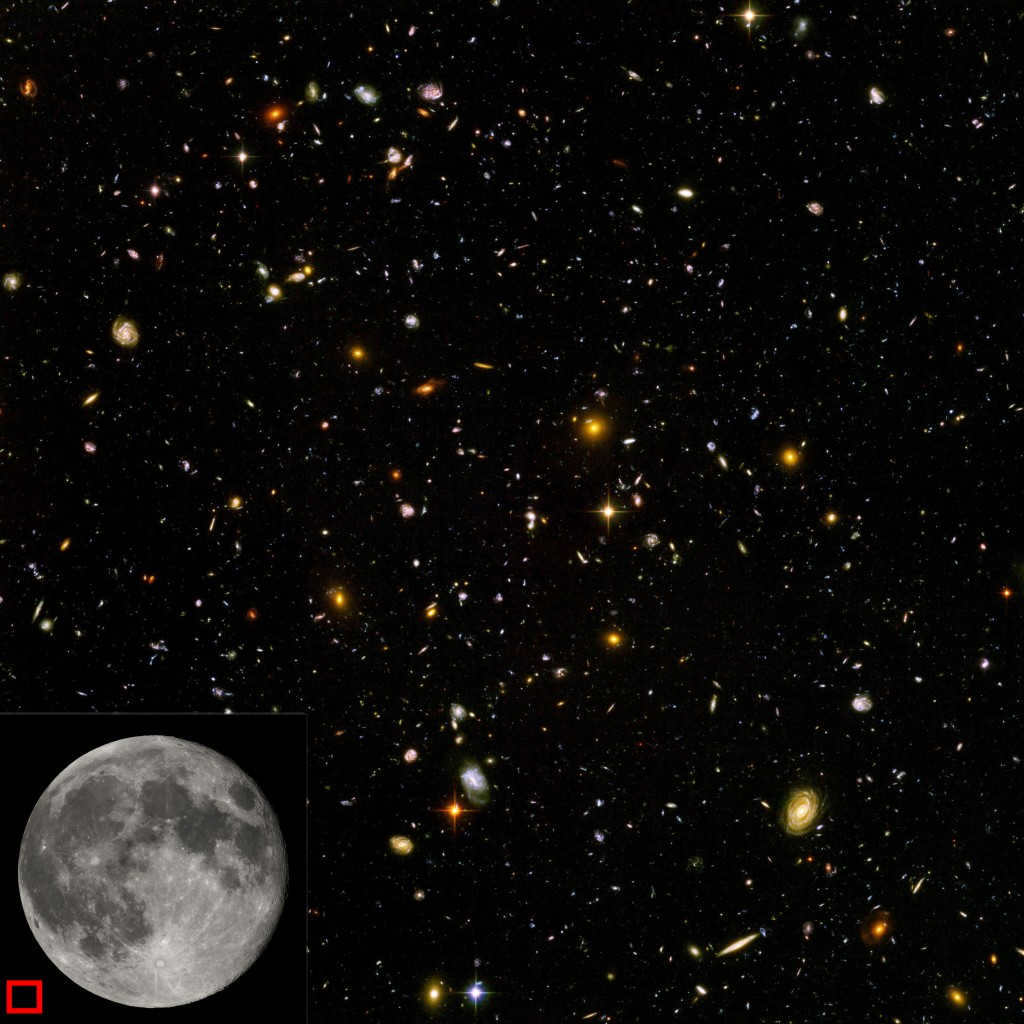
Comparison of the Ultra Deep Field image on a relative scale
To give an approximate figure, let’s consider one of the highly accurate surveys of the cosmos – for instance, the Ultra Deep Field captured by the Hubble Telescope in 2004. Within an area representing 1/130,000,000,000 of the entire sky, the telescope was able to detect 10,000 galaxies. Taking into account similar findings from other deep surveys conducted around the same time, we can take an average. Consequently, within the sensitivity of the Hubble, we observe 130 billion galaxies from the entire universe.
However, that’s not all. Following the Ultra Deep Field, numerous additional images were captured that provided new insights. These images were not limited to the visible spectrum of light that the Hubble operates with, but also included infrared and X-ray observations. As of 2014, we now have access to a staggering 7 trillion 375 billion galaxies within a radius of 14 billion light-years.
However, this is only a conservative estimate. According to astronomers, the presence of dust clusters in the vast expanse between galaxies means that 90% of the objects we observe are obscured – meaning that the number of objects could easily skyrocket from 7 trillion to a staggering 73 trillion. And yet, this number is bound to increase even further once the James Webb telescope begins its journey around the Sun. Unlike the Hubble telescope, which takes days to reach certain areas, the James Webb telescope will cover the same distance in a matter of minutes, enabling it to delve even deeper into the unfathomable depths of the Universe.
Did you enjoy the video? Don’t forget to share it with your friends!
Those individuals who possess a rudimentary comprehension of the vastness of the cosmos are acutely cognizant of its perpetually changing nature. With each passing second, the universe undergoes expansion, incessantly growing larger and larger. However, it is a rather arduous task for the human mind to truly grasp the magnitude of these cosmic occurrences and conceptualize the intricate structure of the Universe. In addition to our own galaxy, which is home to the Sun and humanity, there exist numerous other galaxies, numbering in the dozens, perhaps even the hundreds. The precise tally of these distant worlds remains elusive, as only an approximate estimation can be derived by constructing a mathematical model of the cosmos.
Hence, given the immense expanse of the Universe, it is highly plausible to entertain the notion that there exist worlds akin to ours situated at distances ranging from a dozen to a hundred billion light years away from Earth.
Space and the various worlds that encompass us
Our galaxy, which is aptly named the “Milky Way”, was once believed to be the focal point of the entire universe by many scientists a few centuries ago. However, it has since been discovered that our galaxy is just a fraction of the vast Universe, which contains a multitude of other galaxies of varying types and sizes. Some of these galaxies are larger or smaller than our own, and they can be found at varying distances from us.
Within the vast expanse of space, there exists a intricate web of interconnected objects, each following a specific trajectory and occupying a designated space. Our familiar planets, stars, and even enigmatic black holes, as well as our very own solar system, all find their place within the grandeur of the Milky Way galaxy. The name itself holds significance, as ancient astronomers who gazed upon the night sky likened the celestial realm to a river of milk, where countless stars shimmered like droplets of this creamy substance. Thus, the Milky Way Galaxy encompasses the celestial bodies that grace our field of vision, representing the closest reaches of the cosmos. As for what lies beyond the reach of our telescopes, only in the twentieth century did we begin to unravel this enigma.
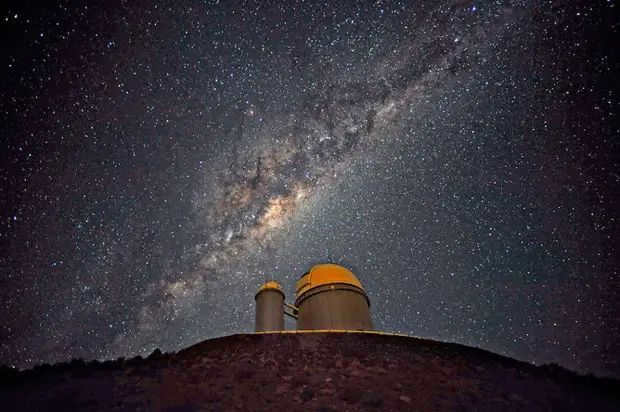
Subsequent discoveries that expanded our understanding of the cosmos to the magnitude of the Metagalaxy prompted scientists to develop the Big Bang theory. This monumental event took place nearly 15 billion years in the past and marked the inception of the processes that led to the formation of the Universe. One phase of matter gave way to another, as the dense clouds of hydrogen and helium gradually gave rise to the primordial structures of the Universe – protogalaxies, which consisted of stars. All of this unfolded in the ancient history of our cosmos. The light emitted by countless celestial bodies, visible through the most powerful telescopes, is merely a final farewell. The millions, if not billions, of stars that adorn our night sky are situated billions of light-years away from Earth and have long since vanished from existence.
Map of the Universe: closest and most distant neighbors
The solar system and other celestial bodies observed from Earth are relatively young structures within the vast Universe. They are our closest neighbors in this expansive cosmos. For a significant period of time, scientists believed that the closest galaxy to the Milky Way was the dwarf galaxy known as the Large Magellanic Cloud, positioned a mere 50 kiloparsecs away. However, recent discoveries have revealed the true neighbors of our galaxy. In the constellations of Sagittarius and Canis Major, there exist small dwarf galaxies with a mass that is 200-300 times less than that of the Milky Way. The distance to these galaxies is just over 30-40 thousand light years.
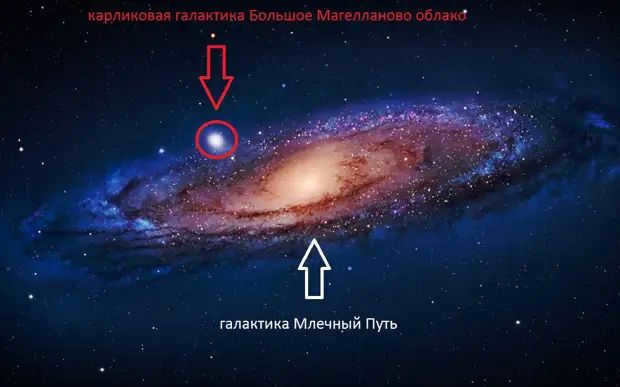
These are a few of the tiniest cosmic objects. The number of stars in such galaxies is relatively limited (approximately a couple of billion). Generally, dwarf galaxies gradually combine or are assimilated by larger structures. The speed of the expanding Universe, which is around 20-25 km/s, will inevitably lead neighboring galaxies to collide. When this will occur and what the outcome will be, we can only speculate. Galaxy collisions are occurring constantly, but due to the fleeting nature of our existence, we are unable to witness the events.
Andromeda, which is approximately two to three times larger than our galaxy, is one of the nearest galaxies to us. It remains a highly popular subject among astronomers and astrophysicists and is situated at a mere distance of 2.52 million light-years from Earth. Similar to our own galaxy, Andromeda is a member of the Local Group of galaxies. This colossal cosmic arena spans a distance of three million light-years and is home to approximately 500 galaxies. Nevertheless, even a behemoth like Andromeda pales in comparison to the size of galaxy IC 1101.
This particular spiral galaxy, which holds the distinction of being the largest in the entire Universe, is situated over a hundred million light-years away and boasts a diameter exceeding 6 million light-years. Despite containing an astounding 100 trillion stars, the majority of the galaxy is comprised of dark matter.
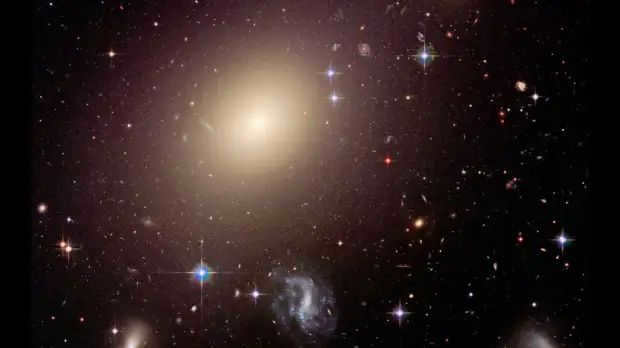
Characteristics of the Universe’s galaxies and their types
The initial investigations of the cosmos, which took place in the early 20th century, provided ample room for contemplation. The space nebulae, discovered through the lens of telescopes, numbering over a thousand, were the most intriguing entities in the Universe. For a considerable period of time, these luminous spots in the nighttime sky were assumed to be gas clusters, constituting a part of our galaxy’s structure. In 1924, Edwin Hubble succeeded in determining the distance to a star cluster and nebulae, leading to a sensational revelation: these nebulae are, in fact, distant spiral galaxies, freely roaming within the Universe’s vastness.

The Universe started to gain a distinct form only with the emergence of advanced technological means of observation. Scientists have come to realize that even immense celestial formations like galaxies can vary in their composition, structure, shape, and size.
Thanks to Edwin Hubble’s efforts, the world now possesses a well-organized classification system for galaxies, categorizing them into three main types:
Elliptical galaxies and spiral galaxies are the most prevalent categories. This includes our own Milky Way galaxy, as well as our neighboring Andromeda galaxy, along with numerous other galaxies scattered throughout the cosmos.
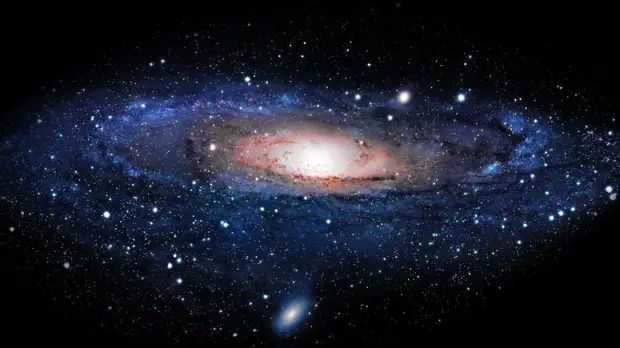
Elliptical galaxies have an elliptical shape and are stretched in one direction. These celestial bodies lack arms and undergo frequent changes in their shape. Additionally, their sizes also differ. Unlike spiral galaxies, these massive entities do not possess a well-defined center. The core is absent in these structures.
Based on the classification, elliptical galaxies are identified by the Latin letter E. Currently, elliptical galaxies are categorized into subgroups E0-E7. The subgroups are determined by their shape, ranging from nearly round galaxies (E0, E1, and E2) to highly elongated objects represented by E6 and E7. Within the category of elliptical galaxies, there are both dwarf and giant galaxies with sizes measuring millions of light-years in diameter.
Spiral galaxies consist of two subtypes:
The first subtype is characterized by the following characteristics. In terms of shape, these galaxies bear a resemblance to a typical spiral, but they possess a central bar that gives rise to arms. These bar structures in a galaxy are typically formed due to physical centrifugal processes that divide the galactic nucleus into two sections. Some galaxies even have two nuclei, with the combination of these nuclei forming the central disk. However, when these nuclei merge, the bar structure disappears and the galaxy becomes normal with a single center. Our Milky Way galaxy contains such a bar structure, located within one of its arms where our Solar System resides. According to current estimates, the distance from the Sun to the center of the galaxy is approximately 27 thousand light years. The thickness of the Orion Swan arm, where our Sun and planet are located, spans 700 thousand light years.
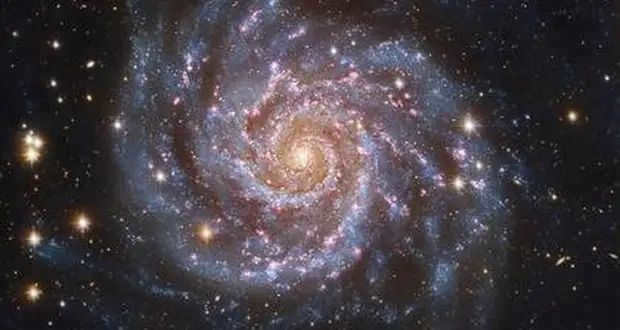
As per the classification, spiral galaxies are denoted by the Latin letters Sb. There are other designations for spiral galaxies based on the subgroups, such as Dba, Sba, and Sbc. The variations among the subgroups are determined by the length and shape of the bar, as well as the arrangement of the arms.
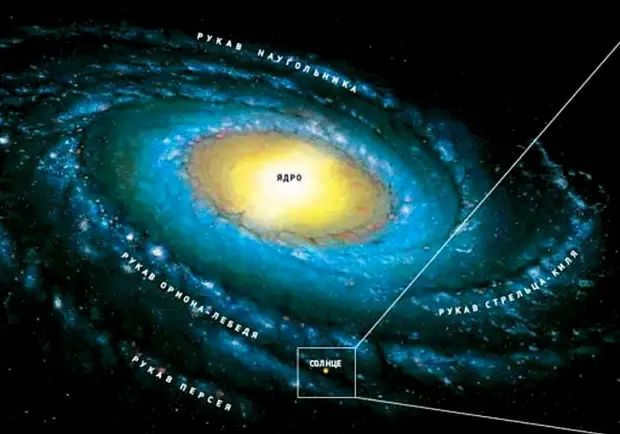
Spiral galaxies come in a range of sizes, varying from 20,000 light-years to 100,000 light-years in diameter. Our galaxy, the Milky Way, falls into the category of medium-sized galaxies, which is often referred to as the “golden mean”.
The least common type of galaxies are irregular galaxies. These cosmic entities consist of large clusters of stars and nebulae, lacking a distinct shape and structure. They are classified as Im and IO galaxies. Typically, galaxies of the Im classification either lack a disk or have a weakly defined one, often resembling sleeves. On the other hand, IO galaxies are characterized by a chaotic arrangement of stars, gas clouds, and dark matter. Notable examples of this galaxy group are the Large and Small Magellanic Clouds.
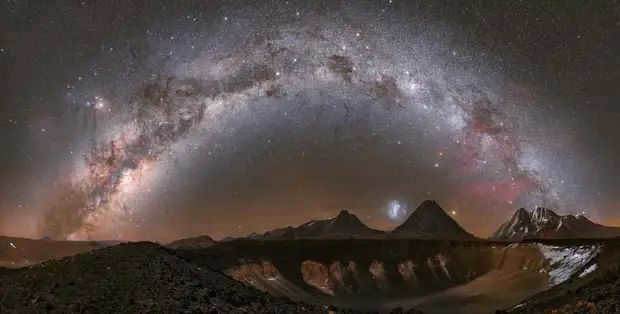
Every single galaxy, regardless of its shape – whether it’s regular or irregular, elliptical or spiral – is composed of countless stars. The vast expanse between these stars, where planetary systems exist, is occupied by either dark matter or clusters of cosmic gas and microscopic dust particles. Within the gaps that separate these celestial bodies, there are both minuscule and massive black holes, disrupting the serene harmony of the cosmos.
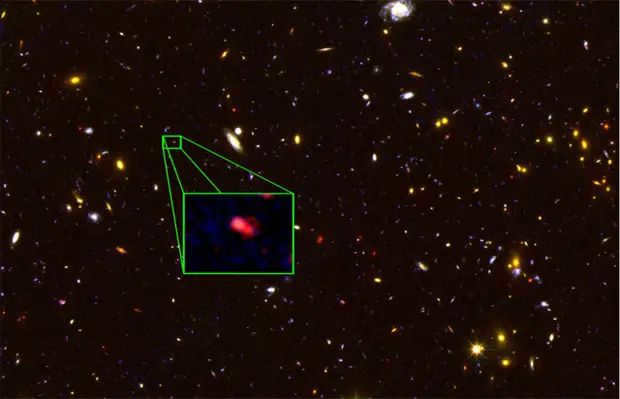
By utilizing the available classification and conducting extensive research, we can provide a reasonably accurate answer to the inquiry regarding the quantity and types of galaxies present in the Universe. Amongst all universal entities, spiral galaxies are the most abundant, constituting over 55% of the total. On the other hand, elliptical galaxies are comparatively less numerous, accounting for merely 22% of the overall count. Irregular galaxies, akin to the Large and Small Magellanic Clouds, comprise a mere 5% of the Universe. While some galaxies exist in close proximity to us and fall within the observation range of the most powerful telescopes, others reside in the most distant corners of space, where dark matter prevails and the lens captures the profound darkness of the vast cosmic expanse.
Examining Galaxies Up Close
Every galaxy is categorized into specific groups, which are commonly known as clusters in modern science. The Milky Way is one of these clusters, housing approximately 40 known galaxies. This cluster itself is a component of a larger group of galaxies known as a supercluster. The Earth, along with the Sun and the Milky Way, resides within the Virgo supercluster. This serves as our current cosmic location. Within the Virgo cluster, there exist over two thousand other galaxies, including elliptical, spiral, and irregular ones.

Astronomers today rely on a map of the Universe to gain insight into its appearance, shape, and structure. The clusters in the map are found surrounding voids or bubbles made of dark matter. It is possible that these dark matter bubbles are also populated with some form of matter, such as antimatter, which defies the laws of physics and forms similar structures in an alternate frame of reference.
The current and future condition of galaxies
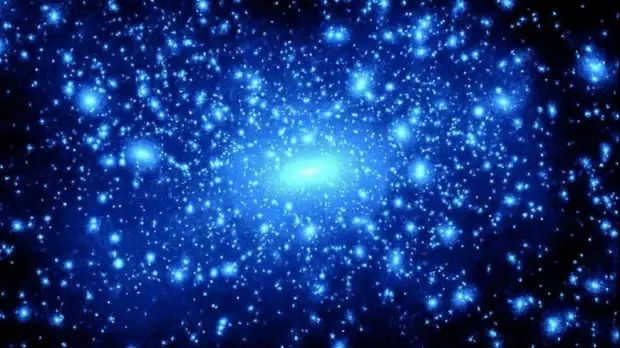
Scientists maintain that creating a comprehensive depiction of the Universe is an unattainable feat. We possess visual and numerical information pertaining to the cosmos that falls within our grasp of understanding. However, the true magnitude of the Universe eludes visualization. What we witness through a telescope is the light emitted by stars that have journeyed towards us for billions of years. It is conceivable that the current portrayal differs significantly from what we perceive today. The exquisite galaxies, born from celestial cataclysms, may have already transformed into desolate and unsightly conglomerations of interstellar particles and enigmatic substances.
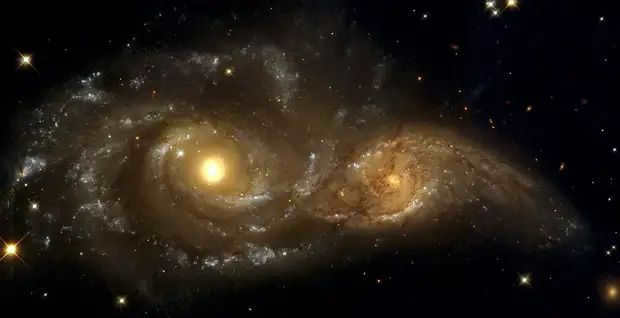
It is not impossible to imagine that in the distant future, our galaxy will experience a collision with a larger neighboring galaxy in the vastness of the Universe or engulf a nearby dwarf galaxy. The consequences of such cosmic events are still unknown. While the merging of galaxies occurs at incredible speeds, it is unlikely that humans will bear witness to this universal catastrophe. Mathematicians predict that this fateful collision is more than three billion Earth years away. The question of whether life will still exist on our planet at that time remains uncertain.
There are also other factors that could potentially disrupt the existence of stars, clusters, and galaxies. For instance, the existence of black holes, which have been discovered by mankind, poses a risk of engulfing entire stars. Furthermore, there is no guarantee that these colossal monsters, lurking within the darkness of dark matter and the vastness of space, will not be capable of devouring galaxies in their entirety.
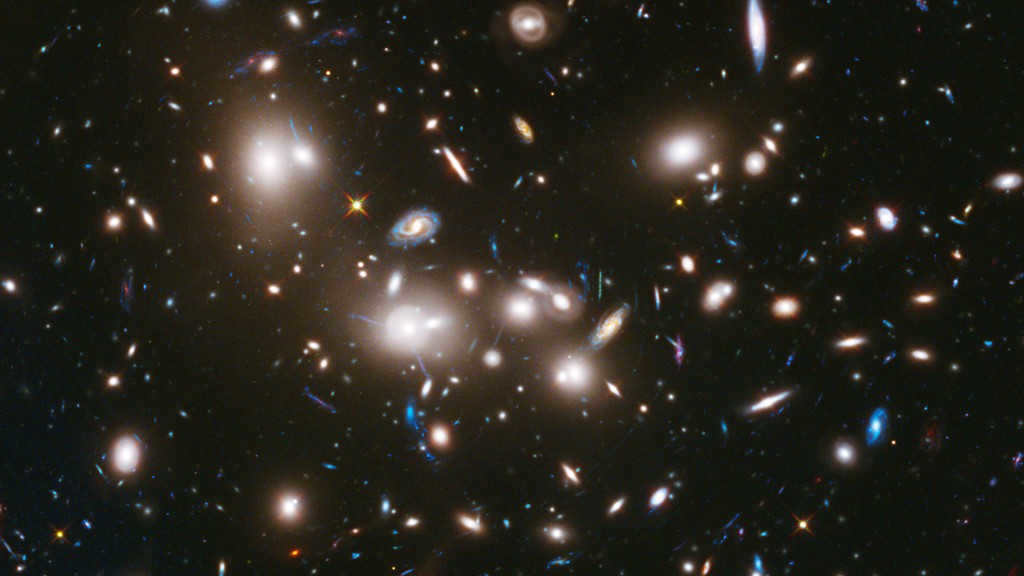
In our previous discussion, we touched upon the fact that the galaxies in the Universe remained a mystery to humanity in the early 1900s. However, our understanding has since expanded, revealing the plethora of distinctive shapes and arrangements, as well as the extensive timeline and unpredictable nature of these celestial entities. Galaxies can be observed as vast constellations of stars, voyaging through the expanse of space, engaging in cosmic dances and merging together. Today, we will delve into the remarkable diversity exhibited by galaxies.
What is the Definition of a Galaxy?
When we think of a galaxy, the image that often comes to mind is the traditional depiction seen in encyclopedias and documentaries – a massive spiral of bluish smoke, with clusters of stars hidden within and a brightly shining core at its center. However, this “star island” is just one type of regular structure. In addition to these, there are also irregular galaxies that lack distinct cores and arms – they float through space like a weightless, broken egg. From a distance, they bear a striking resemblance to chaotic nebulae; the only difference lies in their size and star concentration.
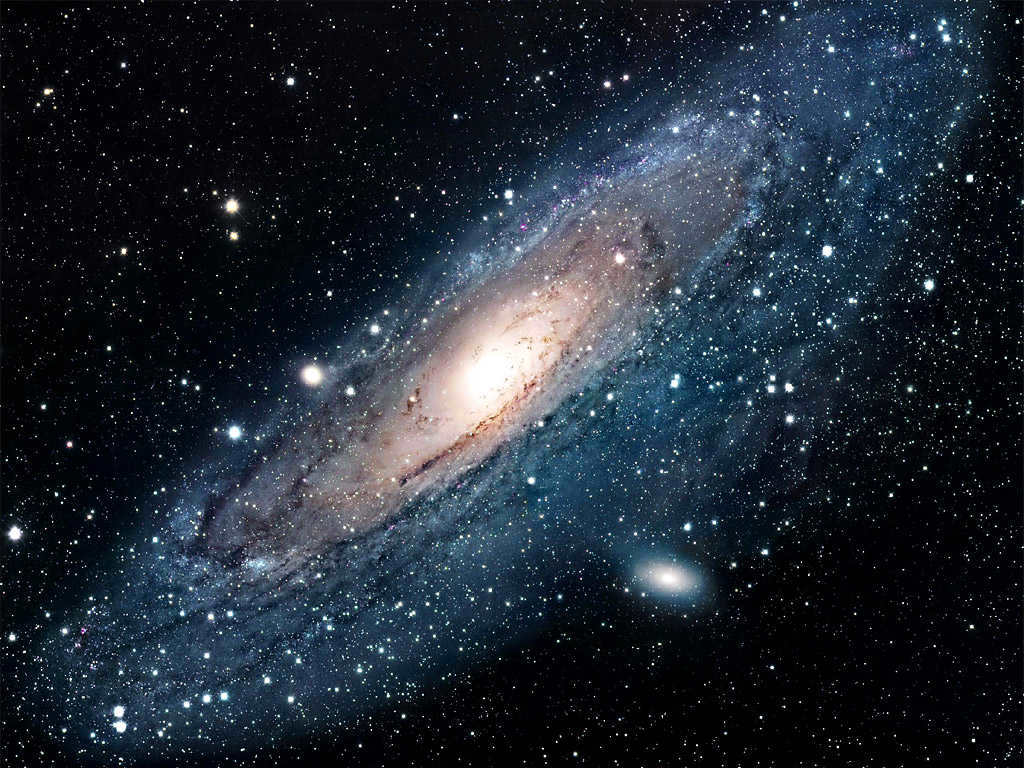
The Andromeda Galaxy stands as the nearest expansive galaxy to our location.
So, what are the criteria for classifying an entity as a galaxy?
- First and foremost, the presence of stars and star clusters is essential – they constitute the majority of visible matter within the galaxy. However, it is important to note that most of the mass within any galaxy consists of layers of gas and dust, molecular clouds, and dark matter, which are not visible.
- Secondly, all of this abundance must be held together by a gravitational system and exhibit rotational movement around a shared center of mass. Typically, this center is referred to as the galactic center, which will be further discussed – although its absence does not pose a hindrance.
- In addition to the internal gravitational interaction, galaxies engage in interactions with one another. Smaller “stellar archipelagos” orbit around the larger ones, and they establish connections with other behemoths, contributing to the overall structure of the Universe. However, unlike planets and their moons, galaxies are infamous for their predatory tendencies. Our very own Milky Way is on the verge of being devoured by its companions, the Large and Small Magellanic Clouds, in a few billion years – and subsequently, it will succumb to being engulfed by the Andromeda Galaxy.
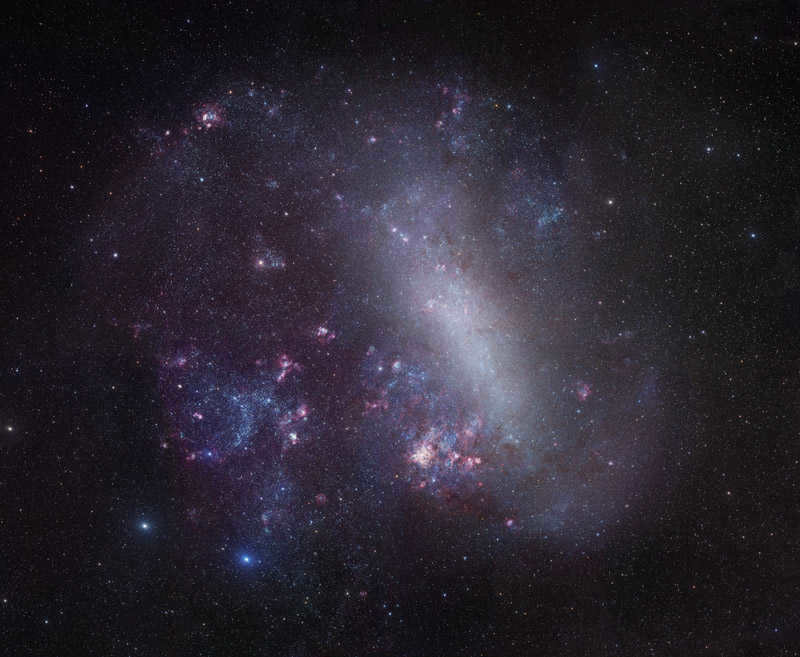
The Large Magellanic Cloud is a satellite galaxy of the Milky Way.
- Galaxies vary in size, with some containing hundreds of millions of stars within a radius of a hundred or two light-years, while others have countless thousands of stars scattered within the same hundred light-years. The main criterion for classifying galaxies is their gravitational separation from nearby “islands” and the presence of their own center of mass. As a result, there are galaxies in the Universe that range from several thousand stars to hundreds of trillions of stars.
There is a lack of a distinct framework or definition for the notion of what constitutes a galaxy, as can be observed. This is the reason why galaxies are so varied, often defying imagination. Among these are exceptionally luminous and potent quasars, as well as the Great Attractor, and vast star fields that span millions of light years. However, even the most typical galaxies possess elements that are capable of eliciting surprise. This is the aspect that we will be examining in the subsequent discussion.
The variety of galaxies

E.P. Hubble holding a picture of the Andromeda galaxy.
When examining galaxies, the most noticeable aspect is their shape and arrangement. Certain galaxies bear a resemblance to the spiral form of cyclones in Earth’s atmosphere, while others appear similar to garden sprinklers that emit jets of water. Additionally, there are galaxies that exhibit a uniform, flat disk-like structure. These distinctive features serve as the foundation for the contemporary categorization of galaxies, known as morphological (morphology refers to the study of the structure and shape of objects).
Ever since Edwin Hubble first began his exploration of galaxies, there has been a hypothesis regarding how their appearance is linked to their age. Initially forming as a compact and dense collection of gas and stars, galaxies slowly extend their arms or expand and contract. As a result, the visual characteristics of a “stellar island” can provide valuable insights into its past.
The structural elements of a galaxy
Edwin Hubble, the trailblazer and pioneer in studying “stellar archipelagos” beyond the Milky Way, initially categorized galaxies into 3, and later 4, main types. The exploration and analysis of these types continues to this day. However, the current typology of “stellar archipelagos” is based on the morphological elements of a galaxy. Similar to a construction set, any galaxy can be assembled using these parts. Astronomers differentiate the following elements:
- The galactic nucleus is the central part of the galaxy, where the majority of its mass is concentrated. It acts as a gravitational anchor, holding together all the other components of the galaxy. The nucleus can either be a single celestial object, such as a black hole, or a collection of stars, dust clouds, black holes, and other entities that reside in the galactic center. Typically, when we refer to the nucleus, we are talking about the latter option, which is also known as an active galactic nucleus. Unlike regular stars, an active galactic nucleus exhibits ongoing processes and emits radiation that is not solely generated by stellar activity.
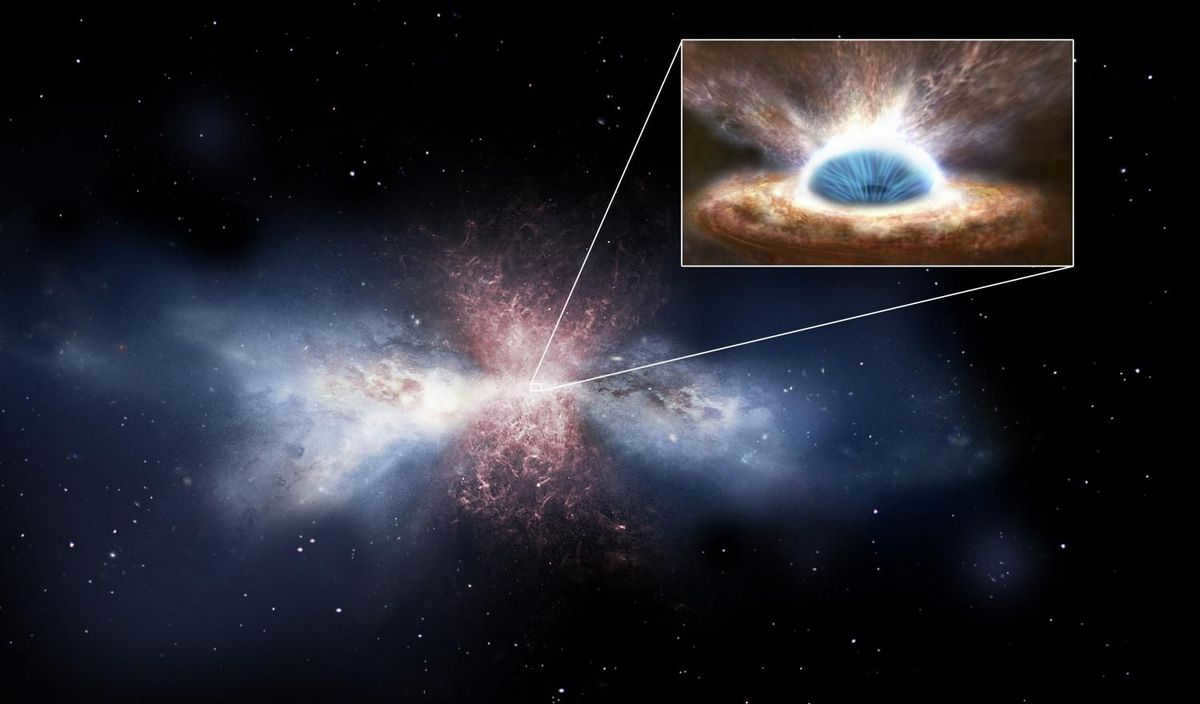
A black hole located at the center of the galaxy
- The galactic disk is a thin and flat layer of the galaxy where most of its contents rotate. It is similar in principle to the ecliptic plane of the solar system, where the orbits of the largest planets are located. The disk is also the most prominent part of the galaxy, covering the largest area. It can be divided into two main components: the gas-dust disk and the stellar disk.
- The disk can exhibit spiral branches, also known as galactic arms. These arms are less dense compared to other parts of the galaxy and are home to numerous young stars.
An interesting fact is that some galaxies have two disks at the same time, known as polar rings. The additional disk, consisting of stars and nebulae, does not always have a common center of mass with the main disk. Polar galactic rings usually form during galaxy mergers or the spontaneous formation of a second galactic center, although the exact mechanism is still unknown.
- The spheroidal component refers to the portion of stars and galactic gas that is outside the galactic disk and is situated on the sphere of attraction around the nucleus. Its contribution to the total mass of the galaxy can vary.
- Balge (derived from the English word “swell, bulge”) is a spherical shell that encompasses the central region of a galaxy. It is composed of large massive stars, elderly luminaries, and globular star clusters. The bulge is the most densely packed and brightest section of any galaxy. Its presence serves as an indication of the existence of a supermassive black hole. Adjacent to the bulge, there can be a bar (derived from the English word “jumper”) which acts as an elongated bridge connecting the bulge to the galactic arms.
- When the balge forms part of the central spheroidal component of the galaxy, the halo envelops the entire outer region of the “star island”. It represents the largest component of the galaxy as it extends well beyond the disk, and is also the most massive since it predominantly consists of dark matter.
Galaxy classifications
Identifying the class of a galaxy is a simple task once you are familiar with its main components. By assessing the presence of the stellar and gas-dust disks, nucleus, and spheroidal component, the class can be determined.
Elliptical galaxies (E)
Elliptical galaxies are the initial category of “star islands” used as a benchmark for other types. They are distinct in that they lack both a disk and arms, essentially being a single massive bulge comprised of a galactic sphere. It is worth noting that the sphere is not perfectly spherical, as elliptical galaxies are always somewhat elongated, which is how they acquired their name.
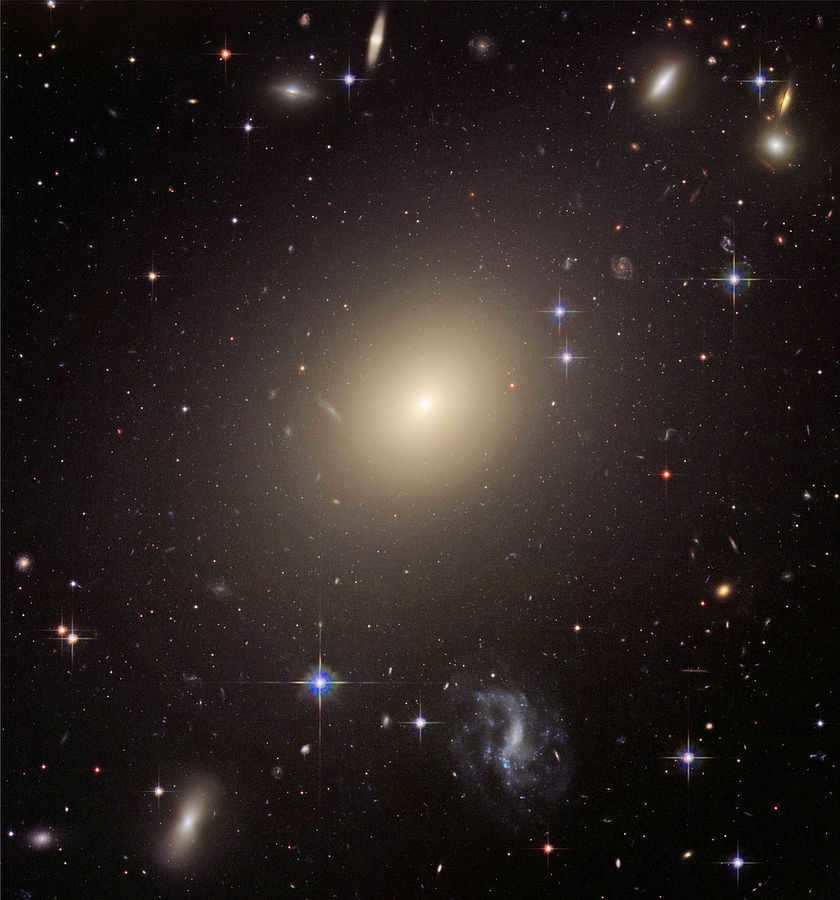
The vast elliptical galaxy ESO 325-G004
The stellar composition within elliptical galaxies is notable for its moderation. The majority of their stars consist of aged red giants or moderate red and yellow dwarfs. While there are a few luminous stars, they seldom reach high positions on the Hertzsprung-Russell diagram – the luminosity of white stars in elliptical galaxies is not particularly strong. Furthermore, blue giants, Wolf-Rayet stars, and other massive and active luminaries are simply absent or exceedingly rare.
Resources about the subject
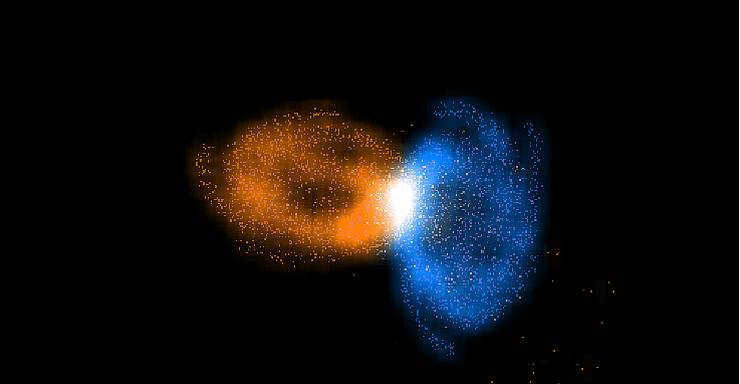
The fact that IC 110, the largest galaxy in the observable universe, is also an elliptical galaxy provides further support for the theory. If this hypothesis is correct, then the collision between the Andromeda galaxy and our Milky Way will result in the transformation of our galaxy into a massive elliptical galaxy.
Lenticular galaxies(S0)
Lenticular galaxies are a unique combination of elliptical and spiral galaxies. They have a dense central region and fully developed disks consisting of stars and gas. These galaxies are often compared to double-convex lenses due to the contrast between their bulging center and flattened disk.
The population of lenticular galaxies is similar to that of elliptical galaxies, consisting of old stars, small mature luminaries, and stellar remnants such as supernovae, black holes, and other objects. While they do not contain much free gas, they do have a sufficient amount of galactic dust. This has led astronomers to believe that lenticular galaxies are the faded descendants of spiral galaxies, where the potential for star formation has been exhausted and the arms have merged.
Lenticular and elliptical galaxies comprise 40% of the total galactic population of the Universe, with each accounting for half of that percentage. Although not as prevalent as spiral galaxies, lenticular and elliptical galaxies are frequently observed in telescope imagery.
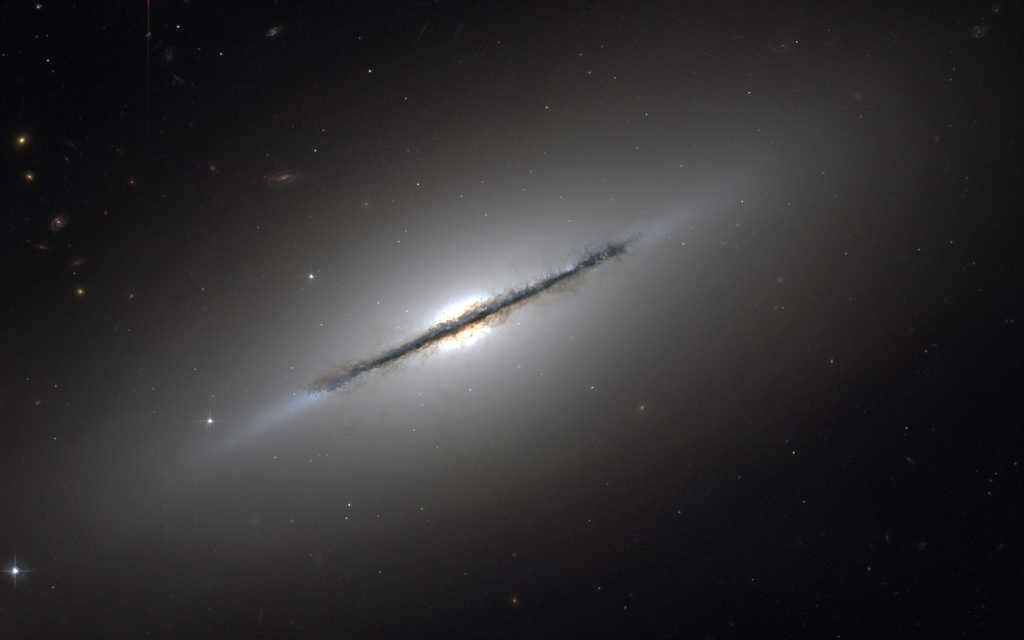
The Spindle or NGC 5866 is a type of lenticular galaxy.
Explanation of Spiral galaxies (S)
A classical example of a spiral galaxy is an elliptical galaxy that has spiral arms extending from its center-bulge. These galaxies are actively rotating, as indicated by their spiral shape, and they have noticeable gas and dust components. The composition of the arms of spiral galaxies differs significantly from the center, as they contain a higher concentration of visible matter, which leads to active star formation. Additionally, a large number of spiral galaxies have a bar junction. Spiral galaxies are the most common type of galaxy in the Universe, accounting for 55% of all “star islands”.
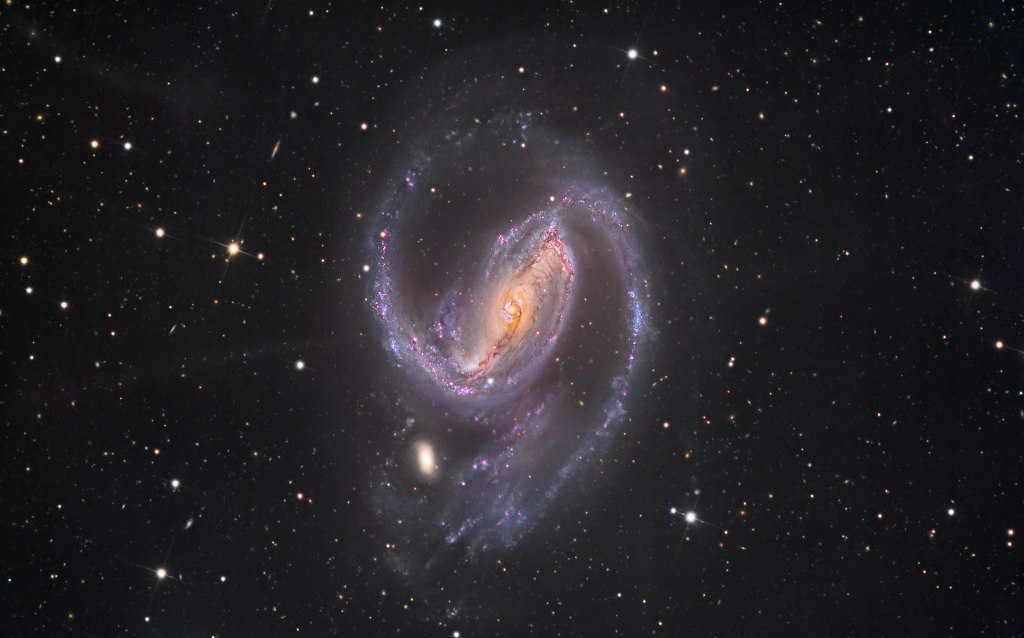
NGC 1097 is a spiral galaxy located in the Furnace constellation.
One of the prevailing explanations suggests that the spiral shape is a result of the influence of density waves. These waves compress the gas and dust clouds, causing them to accumulate in the arms and triggering the formation of stars. The majority of stars formed in the arms are massive and have a bright blue color. These stars have relatively short lifespans, lasting only a few million years, and therefore remain relatively stationary. This characteristic contributes to the stability of the arms.
However, it is important to note that this explanation is just a theory. The complexity of galaxy structure and the inability to observe their long-term development make it difficult to make definitive statements. Nevertheless, it is undeniable that the arms of NGC 1097 contain a significant number of massive and bright stars, resulting in their distinctive blue glow.
Irregular Galaxies(Irr)
Irregular galaxies, also known as Irr galaxies, are a type of galaxy that do not have a defined shape or structure. Unlike spiral galaxies or elliptical galaxies, irregular galaxies do not follow the usual pattern of a central bulge and rotating arms. Instead, they appear chaotic and disorganized, with no distinct symmetry or form.
Irregular galaxies are often smaller and less massive than other types of galaxies. They are also typically found in regions of the universe where there is a higher density of matter, such as galaxy clusters or the outskirts of larger galaxies.
These galaxies are thought to form through a variety of processes, including interactions with other galaxies, gravitational disturbances, and bursts of star formation. The lack of a defined structure in irregular galaxies is believed to be a result of these chaotic formation processes.
Studying irregular galaxies can provide valuable insights into the evolution of galaxies and the processes that shape the universe. They offer a unique perspective on the diversity of galactic structures and the different ways in which galaxies can form and evolve over time.

The NGC 5477 galaxy is an example of an irregular galaxy. Irregular galaxies are the least common type of galaxies in the universe. They have a unique appearance, resembling torn clouds, and their structure is different from other types of galaxies. While they contain a significant amount of gas, dust, and star clusters, they lack the typical features found in spiral or elliptical galaxies, such as spiraling arms or bulges. Some irregular galaxies may have acquired their irregular shape due to gravitational interactions with other galaxies, while others may have formed this way naturally.
Dwarf galaxies are a unique type of irregular galaxies. They contain an abundance of gas necessary for the formation of stars, but have a low concentration of metals (elements other than hydrogen and helium). Additionally, they are characterized by their compact size. These three factors combine to create optimal conditions for the development of large, bright, and short-lived stars. It is believed that these dwarf galaxies resemble the earliest galaxies in our Universe. With the James Webb telescope’s ability to observe events up to 100 million years after the Big Bang, scientists anticipate discovering more irregular galaxies populated by supergiant stars.
If you enjoyed this post, feel free to share it with your friends!

Cosmos
One of the biggest enigmas in the cosmos is the fact that the countless trillions of stars are not evenly scattered throughout outer space. Instead, they are clustered together in galaxies, much like how people gather in cities and leave the areas between them unoccupied.
Our galaxy, known as the Milky Way, is a massive, rotating, flat disk composed of gas, dust, and approximately 200 billion stars. The distance between adjacent stars within the galaxy spans trillions of kilometers of empty space. Our Sun, which is just one of many stars populating the galaxy, resides on its outskirts.
The Milky Way Galaxy
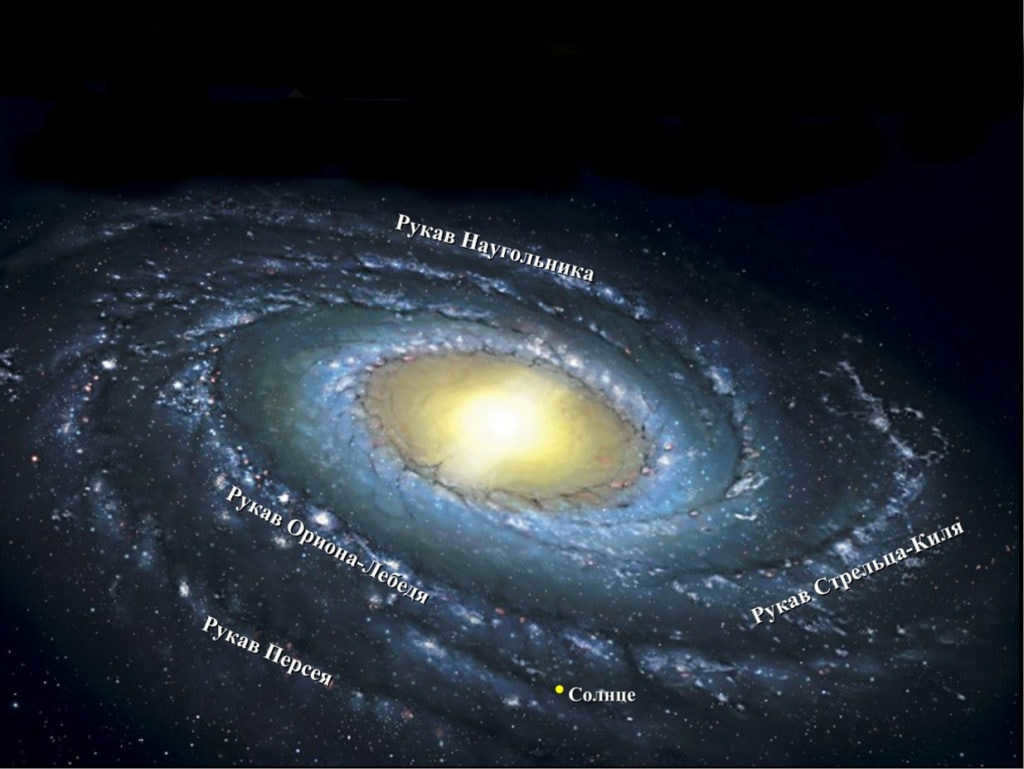
When we gaze up at the night sky, we peer through the twinkling stars, akin to rain droplets clinging to a windowpane. All the individual stars visible in the sky are a part of the Milky Way. Our galaxy possesses a spiral structure. When viewed from above, it resembles a swirling mass of stars. These stars orbit the central region of the galaxy, much like planets orbit stars.
In order to complete a single orbit on this celestial merry-go-round, the Sun requires approximately 200 million years, hurtling through space at a staggering speed of 9,400,000,000 kilometers per hour. When observed from the outside, the galaxy appears as a disk with a prominence at its core. The luminous white strip that stretches across the sky on a clear night is a segment of this disk.
This is our perspective of our galaxy. If we were able to venture beyond it, we would witness the grandeur of the Universe in its purest form: a vast expanse of impenetrable darkness, adorned with brilliantly illuminated galaxies dispersed like beacons in a nocturnal sea. The Milky Way itself is a colossal cosmic entity, but it is merely one of a staggering 100 billion galaxies within the observable cosmos.
Each galaxy, despite being a conglomerate of millions of suns, appears as faint nebulae due to their immense distance from us. With a modest telescope, one can observe a few dozen galaxies. However, with the aid of the most cutting-edge and powerful telescopes, not only can numerous galaxies be scrutinized, but individual stars within some galaxies can also be discerned.
The Andromeda Galaxy
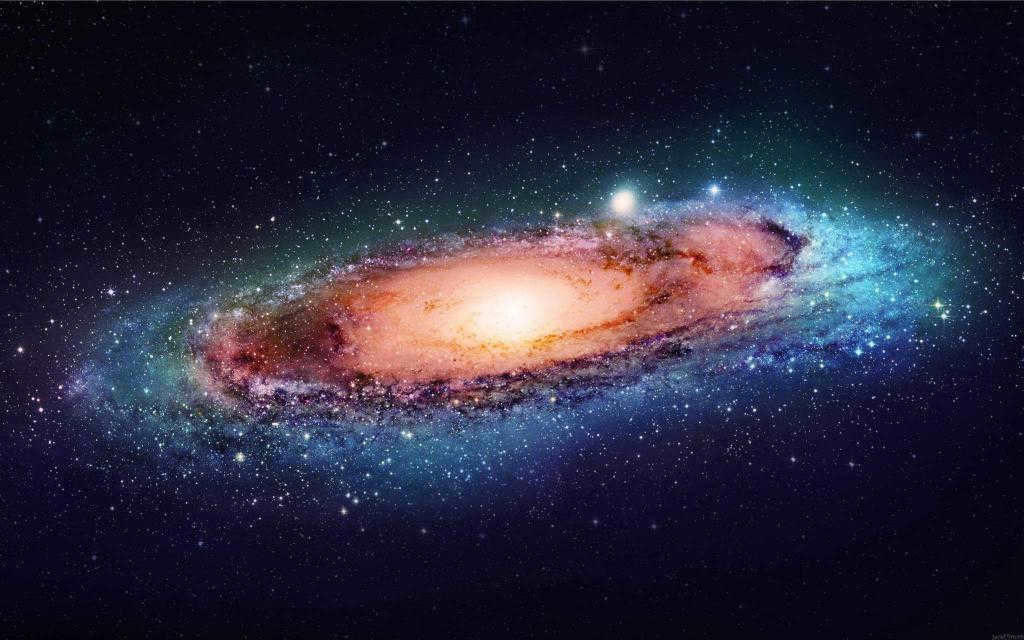
During a particularly clear evening, it is possible to occasionally observe the Andromeda Nebula Galaxy, which is the closest companion to our own Milky Way. Interestingly, no optical instrument is required for this observation. Similar to our own galaxy, the Andromeda Nebula exhibits a spiral shape. In fact, over fifty percent of all galaxies possess this distinct spiral structure. These galaxies, resembling the spinning wheel of a village, contain stars of varying ages, from young to old.
Galaxies with unique forms
There exist galaxies with an elliptical shape. These colossal spherical formations consist of billions of stars. While some of these galaxies possess almost perfect roundness, others are slightly flattened. The stars in elliptical galaxies cluster together around the center, resembling a swarm of bees. Typically, these galaxies are composed of aged stars, many of which are red giants.
As a result, elliptical galaxies often emit red or orange light. Other galaxy shapes also exist, such as those resembling a double-convex lens or spiral galaxies lacking a central bulge. Additionally, some galaxies lack any distinct shape, earning them the classification of irregular galaxies.
Unexpected Incidents in the Galaxy
While on the surface, galaxies may appear to be peaceful and tranquil constellations of stars, their true nature is far from serene. These cosmic realms often serve as the backdrop for violent natural disturbances, comparable to earthquakes and volcanic eruptions here on Earth. A more recent example of such tumultuous activity can be found in the galaxy M87. From its core, there was an immense eruption of scorching blue-white gas, releasing a tremendous amount of energy into the surrounding space. This fiery expulsion stretched across a staggering distance of approximately 5,000 light-years. Scientists believe that the source of this awe-inspiring display is the black hole residing at the galaxy’s center, which devours cosmic debris and entire stars.
Collisions between galaxies
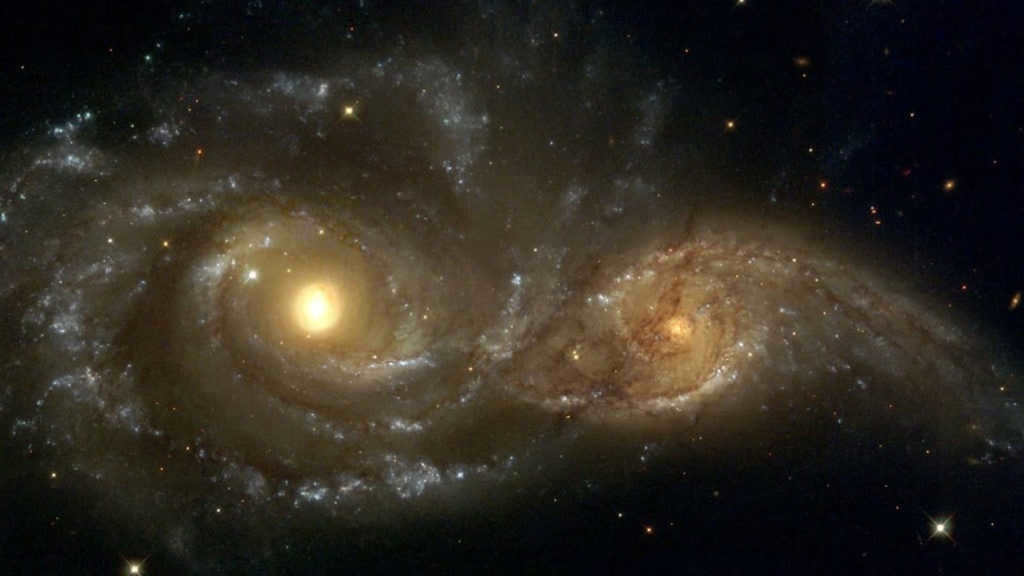
On occasion, galaxies come into contact with one another, resulting in a collision. Due to the vast expanse of empty space between the stars within galaxies, these collisions typically occur without detection. The immense size of galaxies means that these collisions can span several million years, rather than just a few minutes. To study these collisions, scientists use computer simulations to recreate the event. This allows them to observe the effects of galaxies coming into close proximity and predict their appearance afterward. When one galaxy becomes embedded within another, their gravitational fields interact with one another.
There is a suspicion among some scientists that the enormous galaxies we see today may have come into existence through the merging of smaller star clusters. For instance, it is possible that an elliptical galaxy was formed through the merging of two spiral galaxies. We are now able to observe galaxies that are located 2 million light years away from us. This means that the galaxies we see now are actually a snapshot of what they looked like 2 million years ago. Interestingly, the more ancient the galaxies we observe, the smaller they appear to be. Additionally, it has been observed that smaller ancient galaxies often lack a distinct shape. It is believed by scientists that it takes the merging of anywhere from 10 to 100 small galaxies in order to form a spiral galaxy similar to our own Milky Way.

